La Oliva
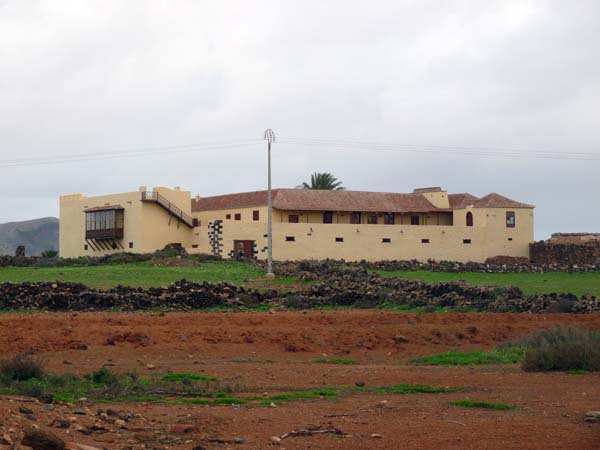
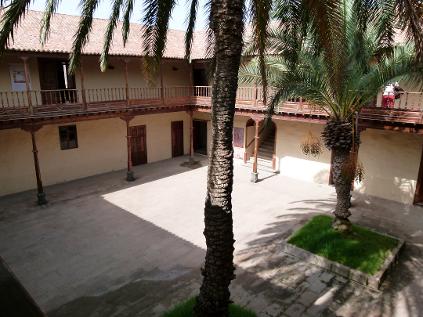

The view from the back of the house
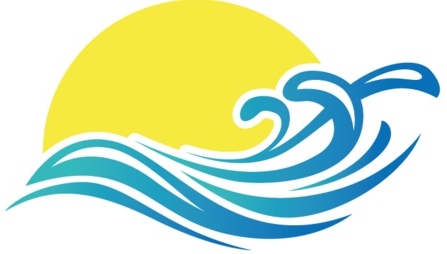
La Casa de los Coroneles
After the conquest of the island for the Crown of Castile by Jean de Bethencourt and Gadifer de la Salle, Fuerteventura was later sold to the house of Arias y Saavedra. It was during this period that La Oliva took on a very important role, with the establishment of the figure of the Land Lord by Philip II and that of the commanding officer, the Colonel, who took charge of the defence of the island when the Lord was absent.
The military government had several high-ranking officers in charge until the Colonel assumed the role of Lord of the island, with the gradual acquisition of responsibilities as well as land, due to the frequent absences of the Lord, the post came to have a hereditary nature. The post of Colonel was created in the early 1700’s and the colonel and his family moved from the historical capital of Betancuria to La Oliva, which became the new capital
This civic-military house was built in the second half of the XV11 century by the Cabrera Béthencourt family and further elaborated upon by their descendants particularly Agustín Cabrera Béthencourt Dumpiérrez (1743-1828), the 5th island Coronel. Its large facade is embellished by many wooden balconies carved in Baroque style and is flanked by two imposing towers.
It is said to have 365 window and door openings, has a large interior patio and many interesting outbuildings.
This fortress-home with its military stamp gave to the people the desired appearance of “Power” for the Coronels mission was to administrate with an iron hand the island of Fuerteventura from the house. The coroneles enjoyed absolute power in the island and saw themselves as superior God-like beings.
This apart the house does have its own beauty and atmosphere: It is open to the public, who are able to enjoy its historical aspects and splendour.
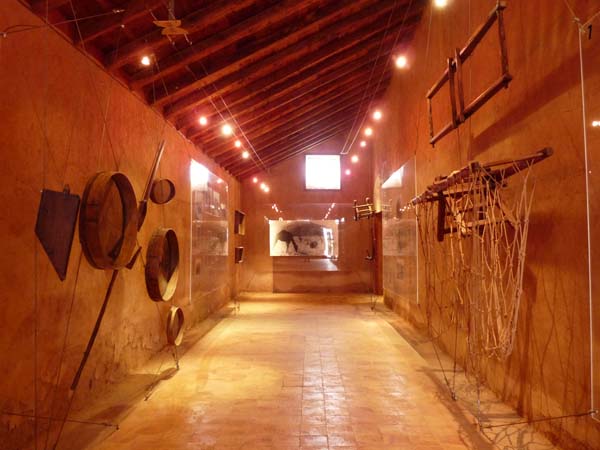
La Cilla Museum of Grain
This houses an exhibition devoted to farming and exhibits old traditional farming implements and the history of farming, once the main economic activity on the island.
Tefia
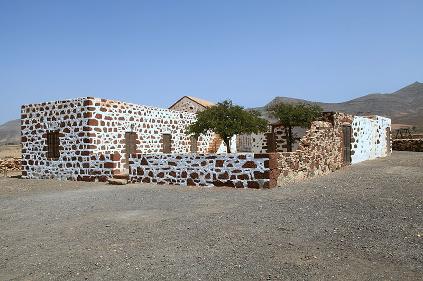
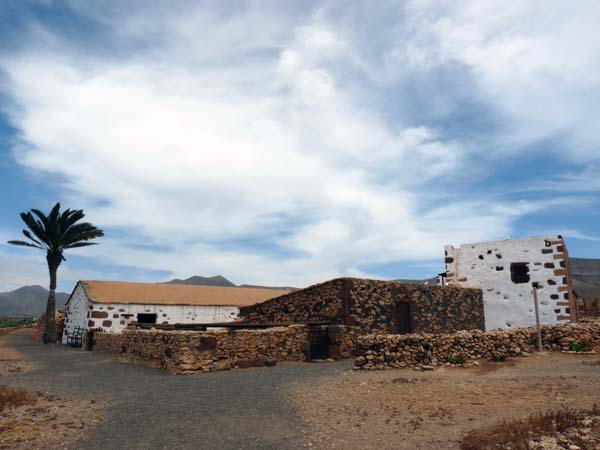
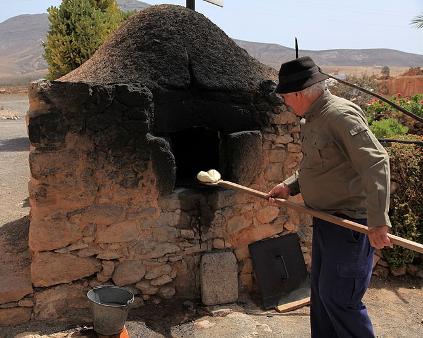
Traditional Bread Baking in a stone oven
La Alcogida Eco Museum
You can really step back into the past at La Alcogida;
Alcogida means land dedicated to rain water collection and La Alcogida is also the name of a small community in the south of Tefia in the north east of the island. This area has been chosen as the site most representative of the traditional domestic architecture of Fuerteventura and, after careful restoration, dedicated as an eco-museum.
The Island Council have restored the houses, enclosures and walls of the small community “La Alcogida” using the original methods and styles of building. What you can see today is an authentic piece of the past restored to its original state.
For those interested in history the community will be of great appeal, for not only can it be seen how the majorero agricultural system worked, but there are also fascinating insights into the past daily life of the island people.
The traditional arts and crafts are being kept alive by classes and demonstrations can be watched when you visit the community.
Due to its low light pollution, Tefia has been chosen by the Fuerteventura Council to house its telescope and there are open nights when you can observe the stars through it.
Los Molinos is nearby, a five minute drive and there is a large reservoir located on the road from Tefia to the small coastal town of Los Molinos, it is the largest fresh water accumulation on the island of Fuerteventura.
Los Molinos is a good place to have lunch, there is a pebbly beach and a catholic shrine decorated with seashells. There are also some interesting rock pools to explore if you are feeling adventurous. A barranco (ravine) feeds into the bay and this creates a nice environment for the ducks that have been introduced.
Puerto Del Rosario
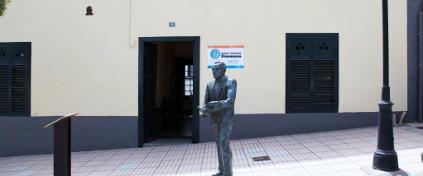
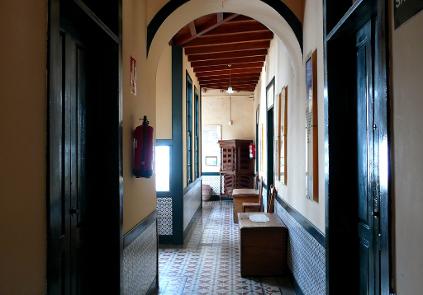
Unamunos House
Located in Puerto del Rosario in the former Hotel Fuerteventura, it is a 19th century house where the exiled writer Miguel de Unamuno lived. The Rector (and lecturer) of the University of Salamanca arrived to stay in March 1924 when he was exiled from Spain for the crime of having criticized the Spanish political situation.
Casa Museo Unamuno is a fine reproduction of the atmosphere of the house in the 1920´s when he stayed there. Donated furniture and photographs of the people in his life on the island help to put the great Spanish philosopher into human context.
There is a monument to Miguel de Unamuno on Mount Quemada in Tindaya. It includes a statue of the intellectual, the work of sculptor Juan Borges.
Unamuno said about this place: “If the end were near and I couldn’t die in my homeland or in Salamanca, I would go to spend my last days there and I would have myself buried atop Quemada Mountain.”
There is a monument to Miguel de Unamuno on Mount Quemada in Tindaya. It includes a statue of the intellectual, the work of sculptor Juan Borges.
Unamuno said about this place: “If the end were near and I couldn’t die in my homeland or in Salamanca, I would go to spend my last days there and I would have myself buried atop Quemada Mountain.”
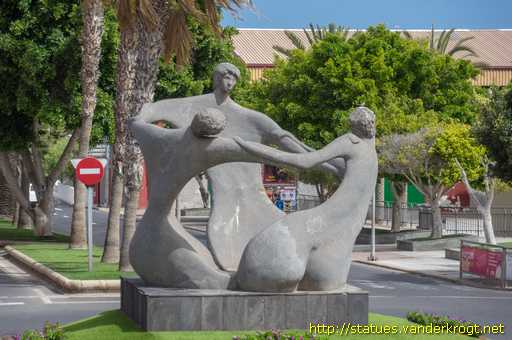
Sculpture Park
Taking a walk around the capital may surprise you as there is so much art, many roundabout, paths and squares have sculptures and the harbour has recently been reconstructed leaving it looking fresh and modern.
The open air exposition has more than 50 sculptures from a variety of artists.
Caleta de Fuste
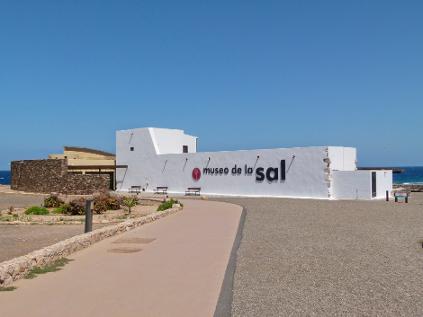
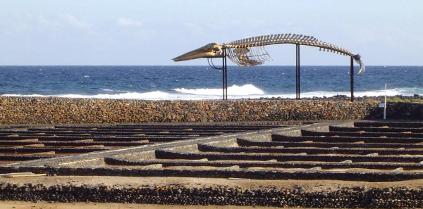
The Salt Museum of Fuerteventura
The salt museum is situated at Las Salinas de El Carmen, a few kilometers south from Caleta de Fuste. It was built in 1910 and restored by the Cabildo (Canarian Government) whose vision it was to create a meeting point of the natural environment (including a great diversity of micro organisms and migratory birds) and the culture generated by the production of Salt, so necessary for human life.
Las Salinas form a part of the history of the island and in its preservation demonstrates respect for the cultural past of the islanders. At Las Salinas you can contemplate a unique landscape of earth, water, sun and wind shaped both by nature and human hand at the meeting point of the earth and the ocean. You can also observe the diverse animal and bird life that can be found living permanently or pausing during their migratory journeys. In the museums interior you can see exhibits demonstrating the formation and history of salt, its eco system and its cultural and practical aspects.
Once you have visited the exhibits you can walk around outside and observe the different processes that were traditionally used to obtain the salt.
Ampuyenta
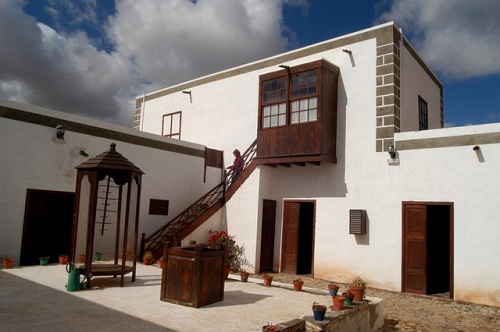
Doctor Mena’s House.
This house has been restored and decorated with the elements of a wealthy rural house from the 19th century, including objects belonging to Dr. D. Tomás Antonio Mena y Mesa, who owned the house.
The doctor, who studied in Havana, Paris, United States, practiced medicine in Cuba and the Canary Islands and is noted for his philanthropic activities on his native island.
The houses considerable dimensions contrast sharply with the more modest homes that surround it.
Antigua
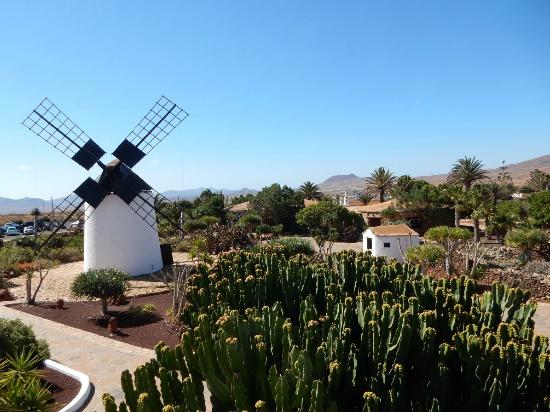
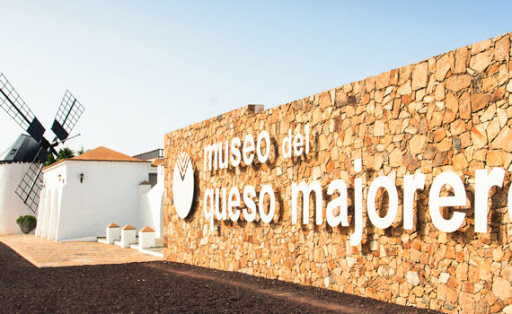
Molino de Antigua Craft Center
The town of Antigua’s origins date back to soon after the founding of Betancuria—the old capital of Fuerteventura—in 1404. The existence of fertile plains in the area which corresponds to the present-day municipality of Antigua, led to the establishment of agriculture. The area quickly developed into an important centre for the production of cereals, and consequently villages and hamlets sprang up there.
Windmills were built for the production of gofio, (the traditional flour made from grains, mainly wheat and maize which was a fundamental part of the islanders diet.)
In Antigua you can visit the molino (windmill) art and craft center, it is set in beautiful gardens that include many types of cactus and palm trees. Adjoining the gardens is a three storey windmill complete with the traditional machinery that was used to work it.
Exhibitions of paintings and archaeology can be seen and sometimes a film of the island is shown.
There are refreshment facilities and a shop selling authentic traditional island craft work.
There is also the Majorero Cheese Museum where you can discover the goats cheese origins and how it is made, the Museum is housed in an old building typical of the architecture of Fuerteventura that formerly housed a goat farm.
Tiscamanita
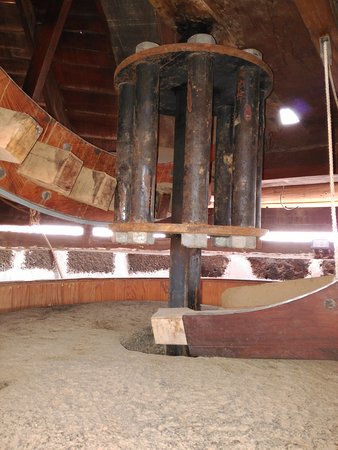
The Milling Center at Tiscamanita.
This center provides visitors with information about the different milling implements used on the island throughout its history. It is housed in a traditional building and has a historical context, there is a windmill nearby which was used to make the past staple of the islanders- gofio (toasted milled cereals)
The center contains four or five small rooms with artifacts related to milling and windmills, The artifacts are interesting as they illustrate the evolution of milling and windmills on the island.
Betancuria
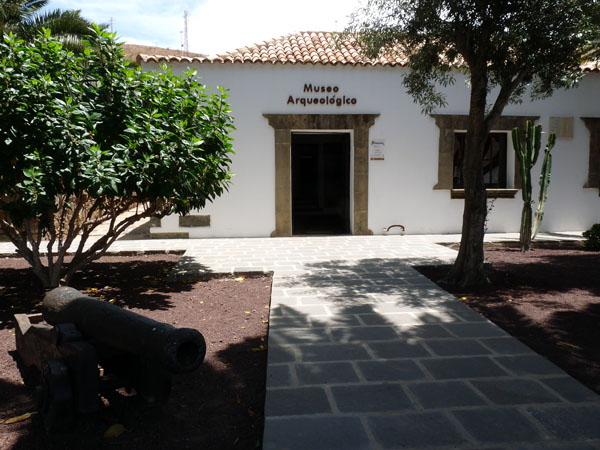
Betancuria Museum.
An old tradional building that has been restored and converted into a museum devoted partly to archaeological materials, paleontological items and ethnographic objects.
Built in the geographical center of the island, the massif called the macizo de Betancuria and devised by the celebrated Cesar Manrique. In this center the incredible landscape of the central north area of the island can be admired from a perspective difficult to find in other places on the island.
Pozo Negro Valley
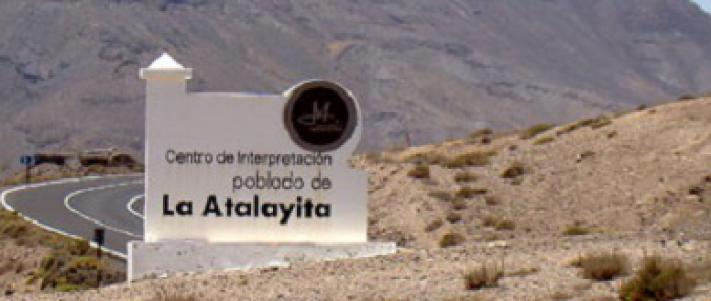
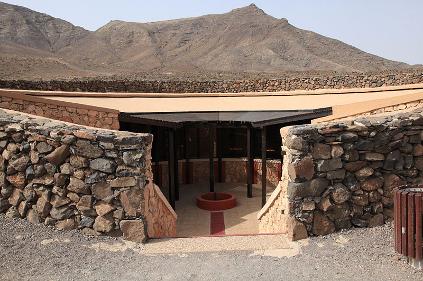
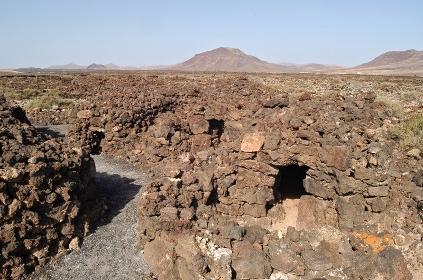
ATALAYITA
(Interpretation Center of the Archaeological Site of La Atalayita)
(Interpretation Center of the Archaeological Site of La Atalayita)
Atalayita, an open air museum is situated in Valle de Pozo Negro, (valley of Pozo Negro)
It occupies a surface of 1.200 m2.The settlement is an archaeological site whose origins go back to the indigenous people of Fuerteventura, the Mahos.
It occupies a surface of 1.200 m2.The settlement is an archaeological site whose origins go back to the indigenous people of Fuerteventura, the Mahos.
Situated in the valley of Pozo Negro in a zone of common land belonging to the Costa de Antigua, these areas have been declared by the government as of great value due to their geology, fauna and flora and also of great cultural value as they hold remnants of the islands past shepherding tradition.
The area covers around 45,000 m2 and paths have been laid out so as you can see the remains of 115 of the original inhabitants stone houses. Made from stones without mortar; the houses are very small, mostly round or elliptical with low, vaulted ceilings and were used as a shelters against the wind.
This area has been used historically for shepherding activities, it was common land used for grazing animals away from the cultivated areas. Periodically the animals were rounded up, counted, marked and some selected for sacrifice. The Interpretation Centre contains many archaeological finds from the area such as aboriginal pottery and ornamentation.
After the conquest the area was also used for shepherds who would stay several months whilst his animals grazed and needing shelter, would make a small stone shelter or use the aboriginal houses, adapting them for their use. The area was used in this way until the 2nd half of the 20th Century, then tomato cultivation was introduced then later, tourism.
There is an Interpretation Centre where you will find information in 3 languages including English.
La Atalayita lies half way between Pozo Negro and the crossroads. Going from the road FV2 take the road FV 420 to Pozo Negro. The Settlement of la Atalayita lies on the left hand side.